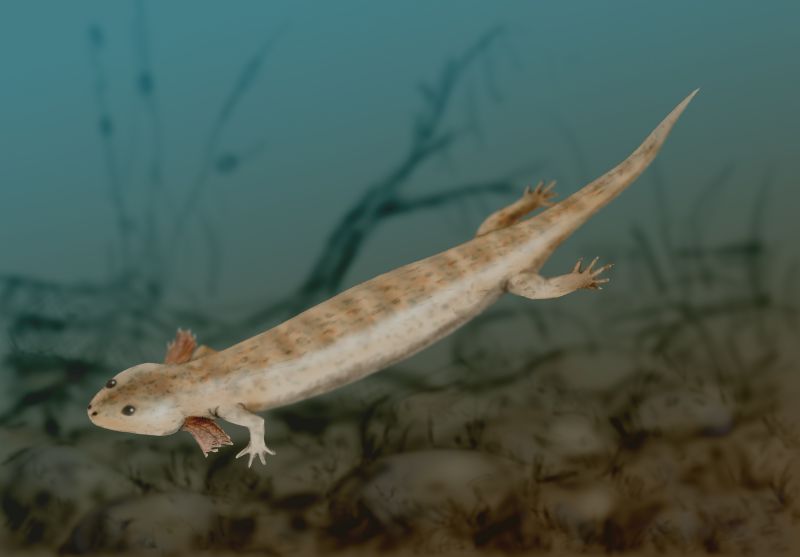|
Altenglanerpeton
''Altenglanerpeton'' is an extinct genus of microsaur amphibian from the Late Carboniferous or Early Permian of Germany. ''Altenglanerpeton'' was named in 2012 after the Altenglan Formation in which it was found. The type species, type and only species is ''A. schroederi''. Description ''Altenglanerpeton'' is known from a single partial skeleton from an outcrop of the Altenglan Formation, which is part of the Saar–Nahe Basin. The Altenglan Formation dates back to the Carboniferous-Permian transition, about 299 million years ago. The skeleton was discovered sometime in the 1870s in the village of Dickenschied#Werschweiler, Werschweiler, and was first described by German paleontologist Eckart Schröder in 1939. Schröder tentatively assigned the specimen to the microsaur ''Microbrachis'', although its classification as a microsaur was questioned in later years. The holotype skeleton includes a crushed skull preserved in dorsal or top view, and a straight length of vertebrae and a ... [...More Info...] [...Related Items...] OR: [Wikipedia] [Google] [Baidu] |
Recumbirostra
Recumbirostra is a clade of tetrapods which lived during the Carboniferous and Permian periods. They are thought to have had a fossorial (burrowing) lifestyle and the group includes both short-bodied and long-bodied snake-like forms. At least one species, the molgophid ''Nagini mazonense,'' lost its forelimbs entirely. It includes the families Pantylidae, Gymnarthridae, Ostodolepidae, Rhynchonkidae and Brachystelechidae, with additional families such as Microbrachidae and Molgophidae being included by some authors. Recumbirostra was erected as a clade in 2007 to include many of the taxa traditionally grouped in "Microsauria", which has since been shown to be a paraphyletic or polyphyletic grouping. Like other "microsaurs", the recumbirostrans have traditionally been considered to be members of the subclass Lepospondyli; however, many phylogenetic analyses conducted since the 2010s have recovered recumbirostrans as basal sauropsid amniotes instead. Not all phylogenetic analyses rec ... [...More Info...] [...Related Items...] OR: [Wikipedia] [Google] [Baidu] |
Altenglan Formation
Altenglan is an ''Ortsgemeinde'' – a municipality belonging to a '' Verbandsgemeinde'', a kind of collective municipality – in the Kusel district in Rhineland-Palatinate, Germany. It belongs to the ''Verbandsgemeinde'' of Kusel-Altenglan. Altenglan is a recognized tourism community. Also, named after the municipality is the Altenglan Formation, a lithostratigraphic entity, and by extension, so is '' Altenglanerpeton'', a microsaur whose fossil remains were found therein. Geography Location The municipality lies in the uplands in the Western Palatinate on the river Glan, which is the village's namesake, at an elevation in the valley of some 200 m above sea level, although the elevations within municipal limits reach almost 400 m (Bistersberg 387 m on the Glan's left bank; Kalmet 390 m on the Glan's right bank), and on the slopes of the Potzberg within the formerly self-administering municipality of Mühlbach almost 500 m. Altenglan lies rough ... [...More Info...] [...Related Items...] OR: [Wikipedia] [Google] [Baidu] |
Late Carboniferous
Late may refer to: * LATE, an acronym which could stand for: ** Limbic-predominant age-related TDP-43 encephalopathy, a proposed form of dementia ** Local-authority trading enterprise, a New Zealand business law ** Local average treatment effect, a concept in econometrics Music * ''Late'' (album), a 2000 album by The 77s * Late!, a pseudonym used by Dave Grohl on his ''Pocketwatch'' album * Late (rapper), an underground rapper from Wolverhampton * "Late" (song), a song by Blue Angel * "Late", a song by Kanye West from ''Late Registration'' Other * Late (Tonga), an uninhabited volcanic island southwest of Vavau in the kingdom of Tonga * "Late" (''The Handmaid's Tale''), a television episode * LaTe, Oy Laivateollisuus Ab, a defunct shipbuilding company * Late may refer to a person who is Dead See also * * * ''Lates'', a genus of fish in the lates perch family * Later (other) * Tardiness * Tardiness (scheduling) In scheduling, tardiness is a measure of a delay in exe ... [...More Info...] [...Related Items...] OR: [Wikipedia] [Google] [Baidu] |
Phylogenetic
In biology, phylogenetics (; from Greek φυλή/ φῦλον [] "tribe, clan, race", and wikt:γενετικός, γενετικός [] "origin, source, birth") is the study of the evolutionary history and relationships among or within groups of organisms. These relationships are determined by Computational phylogenetics, phylogenetic inference methods that focus on observed heritable traits, such as DNA sequences, protein amino acid sequences, or morphology. The result of such an analysis is a phylogenetic tree—a diagram containing a hypothesis of relationships that reflects the evolutionary history of a group of organisms. The tips of a phylogenetic tree can be living taxa or fossils, and represent the "end" or the present time in an evolutionary lineage. A phylogenetic diagram can be rooted or unrooted. A rooted tree diagram indicates the hypothetical common ancestor of the tree. An unrooted tree diagram (a network) makes no assumption about the ancestral line, and does ... [...More Info...] [...Related Items...] OR: [Wikipedia] [Google] [Baidu] |
Sparodus
''Sparodus'' is an extinct genus of microsaur within the family Gymnarthridae. See also * Prehistoric amphibian * List of prehistoric amphibians This list of prehistoric amphibians is an attempt to create a comprehensive listing of all genera from the fossil record that have ever been considered to be amphibians, excluding purely vernacular terms. The list includes all commonly accepted g ... Microsauria {{Lepospondyli-stub ... [...More Info...] [...Related Items...] OR: [Wikipedia] [Google] [Baidu] |
Stegotretus
''Stegotretus'' is an extinct genus of lepospondyl microsaur referred to the Pantylidae. It is known from the Carboniferous–Permian boundary Cutler Formation exposures of New Mexico. History of study Material now referred to ''Stegotretus'' was first described (in brief) by Eberth & Berman (1983). It was formally named by Berman et al. (1988). The genus name comes from the Greek ''stegos'' ('roof') and ''tretos'' ('perforated') to refer to a large fenestra found on the palatine bone. The species name, ''S. agyrus'', is said to be derived from Greek ''agyrus'' ('gathering' / 'crowd') in reference to the concentration of all known specimens in a small area. The proper word in ancient Greek for 'gathering' / 'crowd' is however ''agora'' (ἀγορά), with the variant ''agyris'' (ἄγυρις) in the Aeolic dialect.Liddell, H.G. & Scott, R. (1940). ''A Greek-English Lexicon. Revised and augmented throughout by Sir Henry Stuart Jones with the assistance of Roderick McKenzie.''Ox ... [...More Info...] [...Related Items...] OR: [Wikipedia] [Google] [Baidu] |
Pantylus
''Pantylus'' (from el, παν , 'all' and el, τύλος , 'knob') is an extinct lepospondyl amphibian from the Permian period of North America. ''Pantylus'' was probably a largely terrestrial animal, judging from its well-built legs. It was about long, and resembled a lizard with a large skull and short limbs. It had numerous blunt teeth, and probably chased after invertebrate Invertebrates are a paraphyletic group of animals that neither possess nor develop a vertebral column (commonly known as a ''backbone'' or ''spine''), derived from the notochord. This is a grouping including all animals apart from the chordate ... prey. References External links Skull cast Recumbirostrans Cisuralian amphibians of North America Taxa named by Edward Drinker Cope Fossil taxa described in 1881 {{Lepospondyli-stub ... [...More Info...] [...Related Items...] OR: [Wikipedia] [Google] [Baidu] |
Pantylidae
Pantylidae is an extinct family of lepospondyl amphibians and often considered a sister-group to the family Tuditanidae. The family contains two genera ''Pantylus'' and ''Stegotretus'', while a third, ''Sparodus ''Sparodus'' is an extinct genus of microsaur within the family Gymnarthridae. See also * Prehistoric amphibian * List of prehistoric amphibians This list of prehistoric amphibians is an attempt to create a comprehensive listing of all genera ...'', is sometimes placed here as well. References Recumbirostrans {{Lepospondyli-stub ... [...More Info...] [...Related Items...] OR: [Wikipedia] [Google] [Baidu] |
Microbrachidae
''Microbrachis'' is an extinct genus of lepospondyl amphibian from the Carboniferous Kladno Formation of the Czech Republic. Description ''Microbrachis'' was an elongated, salamander-like creature, about long, with over 40 vertebrae instead of the average 15–26 in its living relatives. It had minute limbs, and probably swam using fish-like lateral body movements. ''Microbrachis'' probably fed on fresh water plankton such as shrimp. ''Microbrachis'' was pedomorphic Neoteny (), also called juvenilization,Montagu, A. (1989). Growing Young. Bergin & Garvey: CT. is the delaying or slowing of the Physiology, physiological, or Somatic (biology), somatic, development of an organism, typically an animal. Neoteny is ..., retaining its larval gills in adulthood. Similar traits are found in the extant axolotl. References Further reading * Andrew R. Milner, "The Tetrapod Assemblage from Nýrany, Czechoslovakia", in Systematics Association Special Volume No.15, "The T ... [...More Info...] [...Related Items...] OR: [Wikipedia] [Google] [Baidu] |
Cladogram
A cladogram (from Greek ''clados'' "branch" and ''gramma'' "character") is a diagram used in cladistics to show relations among organisms. A cladogram is not, however, an evolutionary tree because it does not show how ancestors are related to descendants, nor does it show how much they have changed, so many differing evolutionary trees can be consistent with the same cladogram. A cladogram uses lines that branch off in different directions ending at a clade, a group of organisms with a last common ancestor. There are many shapes of cladograms but they all have lines that branch off from other lines. The lines can be traced back to where they branch off. These branching off points represent a hypothetical ancestor (not an actual entity) which can be inferred to exhibit the traits shared among the terminal taxa above it. This hypothetical ancestor might then provide clues about the order of evolution of various features, adaptation, and other evolutionary narratives about ance ... [...More Info...] [...Related Items...] OR: [Wikipedia] [Google] [Baidu] |
Brachystelechidae
Brachystelechidae is an extinct family of Early Permian microsaurs. The family was first named by Robert L. Carroll and Pamela Gaskill in 1978, with the only member being ''Brachystelechus fritschi''. ''Brachystelechus fritschi'' has since been reassigned to the genus '' Batropetes''. Three genera are currently assigned to the family: ''Batropetes'', from Germany; '' Carrolla'', from Texas Texas (, ; Spanish: ''Texas'', ''Tejas'') is a state in the South Central region of the United States. At 268,596 square miles (695,662 km2), and with more than 29.1 million residents in 2020, it is the second-largest U.S. state by ...; and '' Quasicaecilia'', also from Texas. References External links Brachystelechidaein the Paleobiology Database Microsauria Cisuralian first appearances Cisuralian extinctions {{Lepospondyli-stub ... [...More Info...] [...Related Items...] OR: [Wikipedia] [Google] [Baidu] |
Sister Taxon
In phylogenetics, a sister group or sister taxon, also called an adelphotaxon, comprises the closest relative(s) of another given unit in an evolutionary tree. Definition The expression is most easily illustrated by a cladogram: Taxon A and taxon B are sister groups to each other. Taxa A and B, together with any other extant or extinct descendants of their most recent common ancestor (MRCA), form a monophyletic group, the clade AB. Clade AB and taxon C are also sister groups. Taxa A, B, and C, together with all other descendants of their MRCA form the clade ABC. The whole clade ABC is itself a subtree of a larger tree which offers yet more sister group relationships, both among the leaves and among larger, more deeply rooted clades. The tree structure shown connects through its root to the rest of the universal tree of life. In cladistic standards, taxa A, B, and C may represent specimens, species, genera, or any other taxonomic units. If A and B are at the same taxonomi ... [...More Info...] [...Related Items...] OR: [Wikipedia] [Google] [Baidu] |



.png)